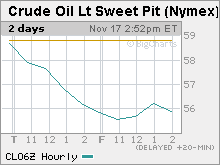Oil's price collapse, more or lessAre we heading back to $40 a barrel, and is talk of $100 crude now silly?NEW YORK (CNNMoney.com) -- Oil inventories are practically overflowing. No one believes OPEC. People are going jacketless in New York and it's nearly December. It's no wonder crude prices tumbled five percent over the last two days, setting a new low for the year.
But does this mean we're headed back to the glory days of $20 a barrel oil, tossing predictions of $100 crude into the the same bin as Pets.com or Dow 36,000? Or is this a spot dip in prices caused by temporary conditions? Most analysts think it's a temporary dip. "I'm not ready to say there's a break down in oil prices," said Jan Stuart, an energy analyst at Fimat. "As yet, there's no real conviction behind it." Stuart, like most experts, noted that for the last several months oil prices have been selling off when the front month contract comes due. The current front month contract for crude is December, which expires at the end of trading Friday. When the contract comes due, investors either have to take delivery of their oil - 10,000 barrels of light, sweet crude - or sell it. Traders Thursday said rising inventories had led storage facilities, mostly located in Cushing Okla., to fill up. That leaves few options for speculators with limited storage facilities of their own - like investment banks. Stuart said the January contract for crude is still trading in the $58 range, while London's Brent has similarly held up. He didn't think oil would go much below $55. On the up side, Stuart said it's hard to see $100 oil, but added "the fact that we can still discuss it and not get thrown into the loony bin is an indication that not much has changed." Other analysts shared Stuart's relatively bullish view on prices. "What appears to be a complete collapse in price, I'm not really sure is an indication of the fundamentals," said Adam Sieminski, chief energy economist at Deutsche Bank. "I don't think prices will go much below the mid $50s." Sieminski lowered his fourth-quarter price target for crude from $70 to $60, saying in a research note that "we see little likelihood that our [previous target price] can be reached absent a huge geopolitical crisis. The US election outcome and change of leadership at the Pentagon suggest to us that a potential confrontation with Iran has been postponed well into 2007." Sieminski believes OPEC, which has been threatening production cuts but has so-far failed to deliver much, will get serious if crude trends into the low $50s. But until then, "there's going to be a lot of downward pressure on price until the traders are convinced the cuts are real," he said. Which, in light of weekly government reports showing ever-rising crude inventories, could be a problem. "I'm doubtful we're going to see much of a decline in imports," said John Kilduff an analyst on the trading desk at Fimat in New York. "A lot of the tanker information just isn't showing the cuts in output they say they're making." "It's debatable how much oil is being taken off the market," said Jim Quinn, a floor analyst for A.G. Edwards at the New York Mercantile Exchange. "I don't know if we'll go into the $40s, but we'll certainly challenge the $50 mark." Although shares of the big oil companies, including ExxonMobil (Charts), BP (Charts), ConocoPhillips (Charts) and Chevron (Charts), have been hit by crude's drop over the last two days, they have generally separated themselves from oil's four month slide, gaining ground since mid September. Crude prices have lost nearly 30 percent since highs reached in July as tensions cooled in the Middle East, prediction of a nasty hurricane season never materialized, fears grew over a slowing economy and speculative money bailed out of the energy sector. ______________ |
|


